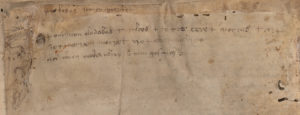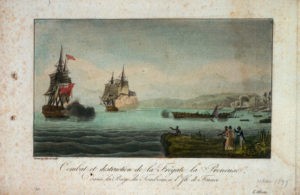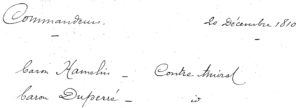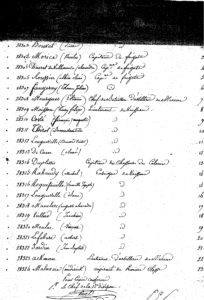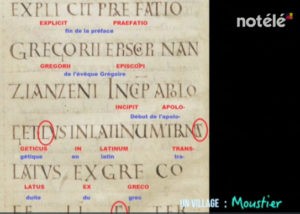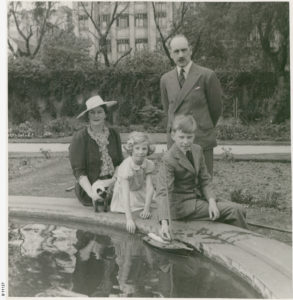Of all the Légionnaires d’Honneur whose full names first appeared just a few days ago, I have to say that Joachim Vieillard currently seems to me – even though we have no family tree for him, so no tell-tale brother “Etienne” – to be our strongest candidate for the Missing Corsair.
I’ll explain why.
Joachim Vieillard: Life and Death
As previously noted, Joachim Vieillard was an enseigne de vaisseau on La Vénus (famously captained by Jean-Jacques-Emmanuel Hamelin) in 1810. His zeal is described here:
Par la vivacité de ses mouvements, du feu de son artillerie et de sa mousqueterie, l’ennemi paraît mieux armé que la Vénus, car il manœuvre, combat, et fait fusillade en même temps ; tandis qu’Hamelin, malgré le zèle des officiers Longueville, Viellard et Mauclerc, est obligé pour brasser, d’appeler ses canonniers, lesquels se multiplient à force de courage et d’activités.
Moreover, Vieillard was wounded in the Battle of Grand Port (though the punctuation looks a little erratic):
Personnel de Marine venant du Port Napoléon en renfort: l’aspirant Prosper tué, blessé l’enseigne de la frégate La Vénus, Vieillard, les aspirants Fautrel blessé et Descombes tué.
Not too surprisingly, Vieillard had previously served as an enseigne de vaisseau on La Manche (see p.49 of this book, and this report by Duperré from September 1810).
Subsequently, Vieillard was promoted to Lieutenant de Vaisseau on 31st July 1816, according to the Annales maritimes et coloniales, Année 1817, part 1 (p.35).
(Note that the entry immediately above Vieillard is for Auguste-Alexandre Mauclerc, one of his fellow Légionnaires d’Honneur from the Indian Ocean, and who we haven’t yet eliminated.)
Knowing that, I was then able to find a reference to a later edition of Annales maritimes et coloniales (supposedly on archive.org, but I only found it behind a geneanet.org paywall), where a paragraph on p.1066 gave the dates both of his birth and of his death:
Joachim Vieillard, lieutenant de vaisseau en activité, né à i’ile Bourbon le 18 avril 1782, mort à Bordeaux le 21 février 1821.
Given that ‘Bourbon’ is, of course, modern-day Réunion, I then went to the British Library to look at the three volumes (and indeed the 2881 pages) of “Dictionnaire généalogique des familles de l’Ile Bourbon (La Réunion) 1665-1810” by Lucien-Jacques-Camille Ricquebourg. However, I found no trace of any Vieillard family members there, which was a bit disappointing.
So… might Vieillard have instead been born in Mauritius? Henri Maurel cites a reference to a testament left by a ‘Vieillard’ dated 20/08/1787 (with the notarial reference “BELIN 1785 – 1809 – Cote CAOM : MAUR 100”), but that’s as far as I got with that thread.
As a result, it seemed for a while that this whole line of enquiry might turn out to be a dead end. But then…
Might Alexandre Dumas Have Saved The Day?
“The Last Cavalier: Being the Adventures of Count Sainte-Hermine in the Age of Napoleon” is a book that was written (and published) in serial form by Alexandre Dumas in the years before his death, though never quite finished: it was recently rediscovered, completed, translated into English, and published as a novel for the first time in 2008.
To a modern book-reading audience, though, it has to be said that the titular protagonist is excessively cartoony (wrestling cayman, sharks, snakes, fencing like a Bond villain, capturing ships, giving his hard-fought winnings away to widows etc). So how it is that Hollywood hasn’t yet snapped it up is arguably a mystery as great as that of any historical cipher. 🙂
In The Last Cavalier, Dumas places Ensign Joachim Vieillard on a pirogue with his captain, the famous corsair Robert Surcouf. When their pirogue is attacked by a huge shark, Surcouf (in Dumas’ story) throws an egg down the monster’s gullet: apparently satisfied, the shark swims off, leaving them in peace.
Moreover, another (somewhat fanciful) piece in the Revue de Paris seems to also link Surcouf to Vieillard… but, unlike Dumas, the author there drops a heavy hint as to one of the sources: the painter Louis Garneray. So: might this link have come from Garneray?
The Louis Garneray Problem
I first encountered Louis Garneray in the context of the 1799 sea-battle between the Iphigénie, Comet, Trincomalee, and Pearl which Garneray’s memoirs claimed he took part in.
The problem is that he simply wasn’t anywhere near any of those ships at the time, and so the account is full of hopeful mistakes which are at odds with the genuine accounts of the battle.
In fact, what almost certainly happened is that some genuine episodes from Garneray’s life at sea that were published in newspapers in the 1840s were picked up by some hack writer(s) and progressively embellished into a book size account until Garneray was (imaginatively) “present” at just about every interesting sea incident of his time. This kind of derring-do sea-faring account was wildly popular in France in the 1860s, which I guess is also probably why Dumas sent his Last Cavalier hero to the Indian Ocean.
All the same, the ever-sober (and ever-reliable) Auguste Toussainte has this to say (in his (1978) “Histoires des Corsaires”, p.113, quoted in Laurent Maneouvre’s “Louis Garneray: 1783-1857: Peintre. Ecrivain. Aventurier”(1997)) about Garneray:
Il y a aussi les mémoires fantaisistes comme ceux d’Edward Trelawny et de Louis Garneray […] De tous les engagements qu’il a décrits, il n’a pu assister qu’à seul, et encore n’est-ce pas certain.
For example, was Garneray on Surcouf’s crew of La Confiance for the battle against the Kent that he so ably painted?
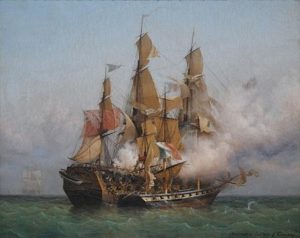
Possibly yes… but almost certainly not. Perhaps, then, it is just as well that – having dredged my way through Garneray’s three memoirs – the link between Surcouf and Vieillard seems not to have originated from Garneray, or else we could easily dismiss it as 1860s derring-do nonsense.
Vieillard the Corsair
Other authors are convinced that Vieillard was a pirate or privateer. Denis Piat, in his splendidly illustrated “Pirates and Privateers in Mauritius” (2014) lists “Vieillard” (no first name) as the final privateer of a long (alphabetical) list (on p.115), but (I believe) does not mention the name anywhere else.
But it turns out that Alexandre Dumas actually dredged his story from the pages of French marine historian Charles Cunat. Having scoured my library at length, I eventually found this referred to on page 123 of Alain Roman’s “Robert Surcouf et ses frères” (2007), where he is referred to as “Joachim Veillard”.
C’est pendant ce séjour aux Seychelles qu’eut lieu une anecdote apportée par Cunat et qi’il certifie avoir entendue de la bouche d’un des témoins, Joachim Veillard. Après une journée passée chez un ami installé dans l’archipel, Surcouf revenait à son bord dans une pirogue conduite par son hôte en compagnie de son second chirurgien et de l’enseigne Joachim Veillard. L’embarcation fut alors attaquée par un énorme requin qui faillit la faire chavirer. Les coups de pagaie at d’aviron ne parvenant pas à le faire sur, Surcouf s’empera d’un oeuf et le lança dans la gueule de l’animal qui disparut aussitôt. Vraie ou fausse, l’histoire permet d’asseoir un peu plus la réputation de sang-froid et d’habileté du corsaire malouin.
My (occasionally over-)free translation would be something like:
It was during this particular stay in the Seychelles that a strange event took place reported by [Charles] Cunat, who attested that he heard it from the mouth of a direct witness, Joachim Veillard. Having spent a day with a friend who lived in the [Seychelles] archipelago, Surcouf was returning to his ship in a small pirogue guided by his host and with his second surgeon and his ensign Joachim Veillard in tow. The little vessel was then attacked by a huge shark, which nearly managed to capsize it. Once it became clear that their frantic oar strokes were failing to get them clear of the danger, Surcouf took an egg and threw it into the mouth of the animal, at which point it suddenly disappeared beneath the water. Whether true or false, this story allows us to grasp a little more clearly Surcouf’s reputation for cool-headedness and skillfulness.
So it seems that if we would like to know more about Joachim Vieillard, we should look at the works of Charles Cunat, who talked with him first-hand. Unfortunately, Gallica doesn’t seem to have a copy of Cunat’s book on Robert Surcouf (the one to which I believe Alain Roman referred): so I have, yet again, ordered myself a copy, and will pick up this particular thread when it arrives from France in 7-10 days.
But all the same, it now does seem likely that Joachim Viellard was indeed an enseigne de vaisseau for Surcouf: which in turn sharply raises the probability that he was our Missing Corsair. For Vieillard was, after all, a corsair, was he not?
